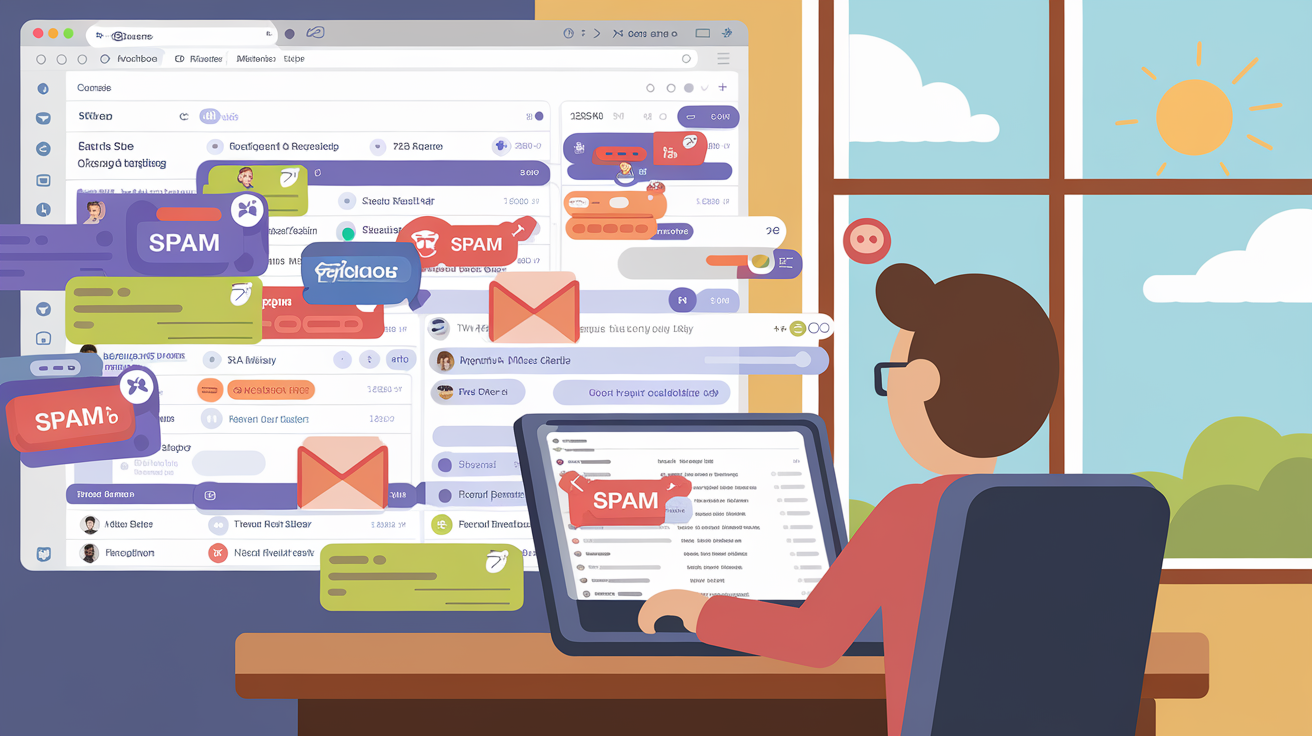Every day, many of us open our Gmail inboxes only to be greeted by a flood of unwanted spam emails, newsletters, and promotional messages from sources we never subscribed to. Managing and deleting these can be a tedious task, especially when important emails get lost in the clutter. If you want to block spam emails in Gmail, here are some simple tricks to help you keep your inbox organized and free of junk.
1. Mass Report and Unsubscribe from Spam
The first step to block spam emails in Gmail is to report and unsubscribe from those you don’t want to receive anymore. Here’s how:
- Log into Gmail and select the spam emails you want to block. Be careful not to select any important emails.
- Click on the small “i” icon at the top, where you’ll see options like “Report spam” or “Report spam and unsubscribe.”
- Choose “Report spam and unsubscribe” to stop receiving emails from those addresses.
By doing this, Gmail will stop those specific emails from appearing in your inbox.
2. Create Filters to Detect and Delete Spam
Another effective way to block spam emails in Gmail is by setting up filters:
- Open Gmail and type “unsubscribe” in the search box to list all promotional emails.
- Select the spam emails you don’t need and click on the three vertical dots at the top.
- Choose “Filter messages like these.”
- Now, create a filter by choosing actions like “Delete” or “Mark as read.” Gmail will apply this filter automatically to future emails.
This method ensures that spam messages are either deleted or labeled as spam without cluttering your inbox.
3. Use a Temporary Email ID
To prevent spam in the future, consider using a temporary email address. When signing up for websites that might share your information, don’t use your primary Gmail account:
- Visit websites like temp-mail.org, which provide free, temporary email IDs.
- Copy the temporary email address and use it on websites instead of your primary Gmail account.
This way, any spam will go to the temporary email instead of cluttering your primary inbox, helping you block spam emails in Gmail in the long run.
Managing spam doesn’t have to be a daily hassle. With these tricks, you can easily block spam emails in Gmail and maintain a cleaner inbox. Whether it’s reporting, unsubscribing, or using filters, you can keep unwanted messages out and focus on what really matters.
What will happen if we do not delete spam email?
If you don’t delete spam emails, several negative consequences can occur, affecting both your Gmail account and personal security. Here’s what might happen if you let spam emails pile up:
1. Cluttered Inbox
Spam emails can quickly fill up your inbox, making it harder to find important messages. As your inbox becomes overwhelmed with junk, you may miss critical emails from work, friends, or other important sources. A cluttered inbox also becomes more difficult to manage over time.
2. Storage Issues
Gmail offers a limited amount of free storage. If you don’t delete spam emails, they will gradually consume your storage space, which may eventually prevent you from receiving new emails. Once your storage is full, you’ll either need to delete emails or pay for additional storage.
3. Increased Spam
Not deleting spam emails can sometimes signal to spammers that your email address is active. This could result in even more spam being sent to your account. Spammers often share active email addresses with other sources, multiplying the amount of junk mail you receive.
4. Security Risks
Spam emails often contain phishing links, malware, or malicious attachments. If you accidentally open or click on these, you could expose your personal information to hackers, putting your privacy and security at risk. Spam emails may also try to trick you into providing sensitive details like passwords or financial information.
5. Slower Email Performance
A large volume of emails, including spam, can slow down the performance of your Gmail account. Searching through emails, loading the inbox, and other actions may take longer if you have too many spam messages piling up.
In short, not deleting spam emails can lead to a cluttered, disorganized inbox, increased security risks, and even potential storage issues. It’s a good habit to regularly clean up spam to maintain a well-functioning and secure Gmail account.
Is there any benefits for not deleting spam email?
There are very few, if any, benefits to not deleting spam emails. In fact, most people would agree that spam emails are more harmful than helpful. However, if we look closely, some people might argue the following minimal reasons for keeping spam emails:
1. Reviewing for Mistakenly Labeled Emails
Occasionally, legitimate emails can end up in the spam folder by mistake. If you don’t delete your spam emails right away, you have a chance to review them and rescue important emails that might have been incorrectly flagged as spam.
2. Learning from Scams
Some people like to keep spam emails to study common tactics used by scammers and phishers. By understanding the patterns and techniques used in spam, they can become more knowledgeable about avoiding future traps. However, this is a niche reason and not common for most users.
3. Tracking Subscriptions
Sometimes, spam emails can remind you of old services, websites, or subscriptions you’ve forgotten about. Keeping them temporarily might give you an overview of where your email address is being used. Read: How to Play GTA V on Mobile: A Step-by-Step Guide Using Steam Link
Conclusion
Overall, these reasons are rare and often not worth the hassle. For the majority of users, deleting spam emails is a better practice to avoid clutter, storage issues, and security risks. It’s best to regularly clean out your spam folder to maintain an organized and safe inbox.
Does Gmail have a spam blocker?
Yes, Gmail has a built-in spam blocker. It automatically filters out suspected spam emails and moves them to the “Spam” folder. Gmail uses advanced algorithms to detect unwanted or suspicious messages, such as phishing emails or those from untrusted sources. However, while Gmail’s spam blocker is effective, it’s not perfect, and some spam emails may still reach your inbox. You can further block spam by manually reporting, unsubscribing, or setting up custom filters to manage unwanted emails.
Why am I getting so many spam emails on Gmail?
Receiving a large number of spam emails on Gmail can be frustrating. Here are some common reasons why you might be getting so many spam emails:
1. Email Address Exposure
If you’ve shared your Gmail address publicly, such as on social media, forums, or websites, spammers can easily harvest it. This increases the likelihood of receiving spam.
2. Signing Up for Services
When you sign up for online services, newsletters, or promotions, you may unintentionally give spammers access to your email. Some companies share or sell email addresses, leading to more spam.
3. Data Breaches
If a website you’ve registered with experiences a data breach, your email address may be exposed to spammers. This can result in an influx of spam emails from different sources.
4. Use of “Catch-All” Addresses
If you use a catch-all email address (an address that collects emails for multiple purposes), it can attract more spam since it’s often used for various sign-ups and registrations.
5. Inadequate Spam Filtering
While Gmail has a good spam filter, some spam emails may bypass it and land in your inbox. This can occur if the spam is well-crafted or mimics legitimate emails.
6. Automated Email List Scrapers
Spammers often use automated tools to scrape the internet for email addresses, including those found in comments, forums, and public profiles.
Some time you should know about How to turn off auto spam in Gmail?
Turning off auto spam filtering in Gmail is not directly possible, as Gmail’s spam filter is designed to automatically detect and filter out unwanted emails to protect users. However, if you feel that Gmail’s spam filtering is too aggressive and mistakenly marks legitimate emails as spam, you can take the following steps to adjust your settings and manage spam more effectively:
1. Mark Legitimate Emails as Not Spam
If you find legitimate emails in your spam folder, you can mark them as “Not Spam.” This action helps Gmail learn your preferences and may reduce the chances of those emails being marked as spam in the future:
- Go to your Spam folder.
- Select the email you want to mark as not spam.
- Click on the “Not spam” button at the top.
2. Create Filters
You can create filters to prevent specific emails from going to the spam folder. To do this:
- Open Gmail and search for emails from a specific sender.
- Select an email from that sender.
- Click on the three dots (More) at the top and choose “Filter messages like these.”
- Create a filter to automatically archive, star, or mark as important emails from that sender.
3. Adjust Spam Settings in Gmail
While you can’t completely turn off Gmail’s spam filter, you can adjust how Gmail handles spam by:
- Going to Settings (gear icon) in Gmail.
- Selecting See all settings.
- Navigating to the Filters and Blocked Addresses tab to manage your filters.
4. Check Email Forwarding and Pop/IMAP Settings
If you’re using email forwarding or accessing Gmail through another email client (like Outlook), check those settings. Sometimes, forwarding can lead to misclassification of spam.
5. Disable Third-Party Apps
If you have any third-party email management apps that interact with your Gmail account, consider disabling them. These apps may interfere with Gmail’s spam filtering.
Question ask by the Gmail User about How to Block Spam Emails in Gmail?
1. How can I block spam emails in Gmail? To block spam emails in Gmail, you can report them as spam, unsubscribe from unwanted senders, or create filters to automatically delete or move these emails to a separate folder.
2. What happens if I don’t delete spam emails? If you don’t delete spam emails, your inbox will become cluttered, making it harder to find important messages. Over time, they will consume your Gmail storage, and you might face security risks if you accidentally click on malicious links.
3. How can I create filters in Gmail to block spam? To create a filter, search for spam keywords like “unsubscribe,” select the emails, click on the three dots, and choose “Filter messages like these.” You can set the filter to automatically delete, archive, or label these emails.
4. Will using a temporary email address help reduce spam? Yes, using a temporary email address when signing up for websites can help reduce spam in your primary Gmail account. This way, spam messages go to the temporary email, keeping your main inbox clean.
5. Can I accidentally block important emails while reporting spam? Yes, it’s possible to block important emails if they’re mistakenly marked as spam. Always review your spam folder before deleting emails to ensure that no important messages were flagged by mistake.
6. Does Gmail automatically filter spam? Yes, Gmail has built-in spam filters that automatically move suspected spam emails to the “Spam” folder. However, it’s not always perfect, so it’s good to manually block and report unwanted emails as well.





